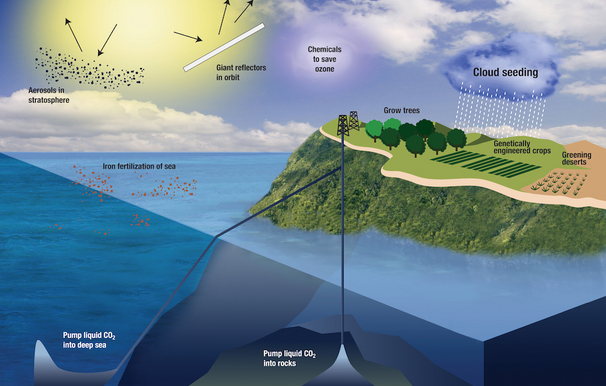Geoengineering Ineffective Against Climate Change, Could Make Worse

Current schemes to minimize the havoc caused by global warming by purposefully manipulating Earth's climate are likely to either be relatively useless or actually make things worse, researchers say in a new study.
The dramatic increase in carbon dioxide levels in the atmosphere since the Industrial Revolution is expected to cause rising global sea levels, more-extreme weather and other disruptions to regional and local climates. Carbon dioxide is a greenhouse gas that traps heat, so as levels of the gas rise, the planet overall warms.
In addition to efforts to reduce carbon dioxide emissions, some have suggested artificially manipulating the world's climate in a last-ditch effort to prevent catastrophic climate change. These strategies, considered radical in some circles, are known as geoengineering or climate engineering.
Many scientists have investigated and questioned how effective individual geoengineering methods could be. However, there have been few attempts to compare and contrast the various methods, which range from fertilizing the ocean so that marine organisms suck up excess carbon dioxide to shooting aerosols into the atmosphere to reflect some of the sun's incoming rays back into space. [8 Ways Global Warming is Already Changing the World]
Now, researchers using a 3D computer model of the Earth have tested the potential benefits and drawbacks of five different geoengineering technologies.
Will it work?
The scientists found that even when several technologies were combined, geoengineering would be unable to prevent average surface temperatures from rising more than 3.6 degrees Fahrenheit (2 degrees Celsius) above current temperatures by the year 2100. This is, the current limit that international negotiations are focused on. They were unable to do so even when each technology was deployed continuously and at scales as large as currently deemed possible.
Get the world’s most fascinating discoveries delivered straight to your inbox.
"The potential of most climate engineering methods, even when optimistic deployment scenarios were assumed, were much lower than I had expected," said study author Andreas Oschlies, an earth system modeler at the GEOMAR Helmholtz Centre for Ocean Research in Kiel, Germany.
One strategy, known as afforestation, would irrigate deserts, such as those in Australia and North Africa, to promote the growth of vegetation that can absorb carbon dioxide. However, this vegetation would also absorb sunlight the deserts currently reflect back into space, thus actually contributing to global warming. That finding supports the results of previous studies.
Another tactic, known as artificial ocean upwelling, would use long pipes to pump deep, cold, nutrient-rich water upward in order to cool ocean-surface waters and promote the growth of photosynthetic organisms that can absorb carbon dioxide. However, the scientists noted that if this strategy were ever stopped, the oceans would rebalance their heat levels, potentially causing disastrously rapid climate change.
One approach, known as ocean alkalinization, would dump lime into the water to chemically increase oceanic absorption of carbon dioxide. Another technique, known as ocean iron fertilization, would dump iron into the oceans to boost the growth of photosynthetic organisms that can absorb carbon dioxide. However, like other geoengineering strategies, the models suggest that both are of little use in reducing global temperatures.
The last method, known as solar radiation management, would reduce the amount of sunlight Earth receives, most likely by pumping reflective sulfate-based aerosols into the atmosphere. The subsequent dimming of sunlight on Earth would cool the planet, but the researchers note that carbon dioxide would continue to accumulate in the atmosphere. This suggests that if this strategy were ever halted, the globe would rapidly warm after the aerosols dispersed.
Possible side effects
All in all, these strategies are relatively ineffective; individually, they reduce global warming by less than 8 percent each, assuming carbon dioxide emission levels continue to remain as high as they are now. In all simulations, atmospheric carbon dioxide levels will still reach more than twice current levels by the end of the century, the researchers found.
Moreover, each geoengineering technique can have potentially severe side effects. For example, solar radiation management would alter patterns of precipitation such as rainfall and reduce total precipitation across the globe.
Altogether, the climate engineering technologies analyzed here are ineffective in reducing carbon dioxide concentrations and in most cases temperature. And this lack of effect "is really striking," said climate scientist Kelly McCusker at the University of Victoria in Canada, who did not take part in this research. McCusker and her colleagues also recently found that a sudden stop in solar radiation management strategies would exacerbate global warming.
"This study nails home the continued importance of reducing our emissions of greenhouse gases," McCusker told Live Science.
The researchers noted they used a moderately complex earth system model, and that more complex models involving a more intricate look at how winds might respond to geoengineering "may give different answers, particularly for precipitation changes," Oschlies said.
Oschlies and his colleagues David Keller and Ellias Feng detailed their findings online Feb. 25 in the journal Nature Communications.
Follow us @livescience, Facebook & Google+. Original article on Live Science.



